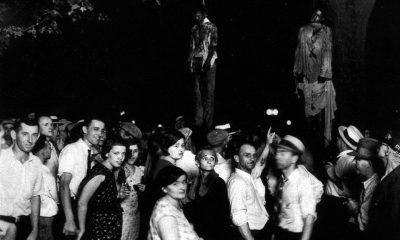United States
Nooses found at Connecticut construction site, Amazon and contractors being sued

When construction workers at an Amazon Wholesale warehouse in Connecticut saw a noose-shaped rope dangling from the ceiling in April 2021, they were shocked. Workers reported the hate symbol immediately to management.
Nooses found at Connecticut construction site
Five more nooses showed up two days later. Two more were found the following month.
Five African-American and Hispanic electricians who worked on the Amazon building in Windsor, Connecticut, have now filed a federal civil rights lawsuit against the company and two contractors. The electricians claim that Amazon and the contractors did not take the problem seriously or take any actions that may have prevented the harassment.
The employees further claim they were treated hostilely and retaliated against after reporting the nooses.
“The appearance of a noose, even one noose, in a workplace sends a clear message of hostility towards the men of color working there: ‘You are not welcome here, and you better watch your back,’ ” the complaint, filed in late September, claimed.
Amazon Wholesale spokesman Steve Kelly told NPR, “Hate, racism, and discrimination have no place in our society and are not tolerated at any site associated with Amazon, whether under construction or fully operational. We cannot provide any further comment at this time due to pending litigation.
The company also stated that it was standing behind local authorities during the probe.
NPR’s request for comment from the two contractors went unanswered.
The team of electricians from Wayne J. Griffin Electric worked on the construction of the Amazon distribution center in Windsor, Connecticut, which is located north of Hartford. The building project’s construction manager was RC Andersen.
The lawsuit claims that the defendants’ reaction to the first two nooses at the construction site was “non-existent and ineffective.” According to the plaintiffs, it wasn’t until the eighth noose appeared that Amazon completely pulled down the site to allow police to investigate. (Contrary to what was reported at the time, the site was only partially shut down when the seventh noose was discovered, according to a lawyer for the electricians.)
The suit further alleges that managers at Griffin Electric and RC Andersen accused the electricians of hanging the nooses themselves when the FBI became involved to aid the local police in their investigation.
“They had vocally complained as witnesses to hateful criminal conduct in their workplace and yet they were now being treated as perpetrators,” according to the complaint. The electricians’ attorney, Steve Fitzgerald, told NPR that his clients “are all now in need of therapy to deal with PTSD and anxiety” as a result of the ordeal.
According to NPR, the Windsor Police Department has not made any arrests. According to the complaint, the FBI is still looking into the matter. (Amazon, RC Andersen, and Scannell Properties, a real estate development company, had offered a $100,000 prize for information leading to the identity of the perpetrators.)
The electricians are asking for money, but they won’t say how much.
The complaint claims that Amazon and the other two corporations had previously received warnings about nooses before the incidents in Windsor.
While renovating the Amazon distribution center in Bloomfield, Connecticut, electricians from Griffin found a noose. According to the lawsuit, a Griffin manager knew many employees saw the noose but did not call the police since there was no photographic evidence.
At the time, RC Andersen was in charge of overseeing the building project.
According to a Washington Post report, between 2015 and 2021, 55 nooses were found at construction sites in the United States and Canada, but just a small fraction of those cases resulted in arrests.
Unless you’ve been living under a rock, you’ll have heard of Amazon — you’ve probably bought something from its website, and know the name and face of Jeff Bezos, its founder. A modern success story, few companies in history can match the success of Amazon. Since its founding back in 1994, Amazon has grown to become one of the biggest companies in the world, and today offers a wide range of products and services to consumers, businesses, and government agencies. The Seattle-based company also employs some 1.5 million people, making it one of the largest employers in the world. It is one of the United States’ “Big Five Companies” along with Apple, Microsoft, Google, and Meta.
On this page, we’ll run through everything you need to know about Amazon, from its humble beginnings to its rapid growth and dominance of the eCommerce sector and beyond.
The Jeff Bezos Pre-Amazon Story
The Amazon story is closely intertwined with the Jeff Bezos story. Born in Albuquerque in 1964, Bezos attended Princeton University before landing his first job as a computer science expert on Wall Street. He later held other job roles at the Fitel Company, as the vice president of the Bankers Trust, and for D.E. Shaw & Company.
But in 1994, Bezos decided to leave employment to put his entrepreneurial spirit to the test. It was on a cross-country drive from New York to Seattle that Bezos put together a business plan for what would eventually become Amazon. Once in Seattle, he set up the company’s first headquarters in his garage and legally registered in the state of Washington.
1994: The Birth of Amazon
Today, you can buy virtually everything on Amazon — but back in 1994, the company was focused entirely on selling just one product: books. Bezos didn’t necessarily have a passion for literature; it was his research, which concluded that books were the most logical product to sell online, that made the decision.
Amazon wasn’t Bezos’ first choice for the name of his company. It was originally named Cadabra, a play on ‘Abracadabra.’ But when Bezos heard a lawyer mispronounce the name as ‘Cadaver,’ he knew that he had to select a more straightforward, easier-to-remember name. He chose Amazon for two reasons: one, because ‘A’ is the first letter of the alphabet, and two, because the Amazon River in South America is one of the largest in the world, which matched the ambitions of his new company, which even back then he planned to turn into one of the biggest in the world.
The site went live in 1995. The look and feel of the earliest incarnation of Amazon.com is a world away from what it is today. It was just a simple text-based website that listed the bare minimum of information about the books being sold; in some cases, even the publication date was missing. Still, the vision was in place, and with $100,000 of capital thanks to Tom Alberg, an early investor, Bezos had the money he needed to put his ‘Get Big Fast” strategy into practice.
Early Doubts
As with all businesses, Amazon’s success was far from guaranteed. Indeed, in the early years, there were plenty of critics who predicted that the company was doomed to fail; even Bezos himself admitted several years after the company’s founding that it’s unclear that he — and the company — would succeed.
But critics that said more established bookselling companies would consign Amazon to history overlooked a crucial detail. Amazon was never intended to just sell books; Bezos chose that product because it was more convenient since books were easy to source and distribute. The vision was always to expand and offer more products and digital services.
Bezos’ strategy was to “Get Big Fast.” In other words, forget about profits and just focus on getting a foothold in the industry. That Amazon didn’t generate a profit until 2001, seven years after launch, shows just how committed Bezos was to this approach. The lack of profits really wasn’t what was important. Getting customers and building revenue was. By 1996, Amazon had more than a million registered customers and by 1997, revenues stood at an impressive $148 million. That figure jumped to $600 million just a year later.
Moving Beyond Books
As we said above: Bezos always knew that Amazon was destined to offer more than books to its customers. By 1997, the company had a large audience and was ready to offer more products.
Phase Two
The company began offering CDs alongside its book inventory in 1997. Soon after, the company began selling videos, home improvement products, toys, software, and electronics. Still, though 1997 – 2000 saw continued growth, doubts remained about the long-term success of the company. And those doubts weren’t coming from outside critics; Amazon investors, who had stumped up cash in the hope of getting a return on their investment, were beginning to grow impatient.
Still, Bezos would hold his nerve and continue with the existing approach. It was around this time that the company’s branding began to take a clearer direction, including the use of black and orange which is still used today.
Phase Three
2001 was a rocky period for tech companies, with many going out of business when the dot-com bubble burst. But with a solid customer base and years of impressive revenue numbers, Amazon was able to ride out the storm relatively easily. It was in this year, in the fourth quarter, that Amazon posted its first profits. More impressive was the revenue for 2001, which stood at more than $1 billion. This was the clearest indication that Amazon’s business model was on track to succeed.
The following decade was Amazon’s golden period which saw exceptional growth. By 2006, the company was generating $10.8 billion and was one of the major technology companies in the United States and across the world. Its online store was diversifying even further, and in 2007, the company launched its first Kindle Reader, which would have a significant impact on the publishing industry. It was also during this time that the company invested heavily in cloud computing, including Amazon AWS. By 2011, Amazon’s website was receiving some 900 million visitors a year.
Phase Four
Phase four of the company involves the diversification of its holdings, especially physical holdings. For instance, in June 2017, Amazon bought the Whole Foods supermarket chain for $13.4 billion. It also invested heavily in Amazon Go, a supermarket store without employees where sensors detect what customers have taken from the store and automatically charge their cards.
This period also saw the expansion of the company’s headquarters, with plans to open up a second HQ to join the company’s primary headquarters in Seattle. After considering bids from around the United States, the company chose to build its new headquarters in Arlington, Virginia.
Technology Services
Amazon is primarily thought of as an eCommerce company. But it’s really a technology company that sells products. In 2002, the company launched Amazon Web Services (AWS). Initially, this service provided developers and marketers with data on site popularity, internet traffic patterns, and other pieces of valuable information that they could use to optimize website performance. Later, in 2006, added Elastic Compute Cloud (EC2) and Simple Storage Service (S3) to its AWS offerings. EC2 allows companies to rent processing power in their chosen increments; S3 offers web-based data storage.
Today, cloud storage is commonplace, but only because Amazon popularized the concept. S3 was instantly popular, holding more than 10 billion data objects within a year of its launch — within five years, it held close to 100 billion data objects. The success of S3 and EC2 was significant and played a large role in helping Amazon stay at the top of the technology world even when new rivals emerged. Netflix, for instance, is a competitor of Amazon yet relies on both EC2 and S3 for its streaming service.
Revolutionizing the Publishing Industry
Amazon has had a demonstrable impact on the commerce industry. It is difficult to compete with Amazon’s prices, whether online or offline. And that’s not the only industry that Amazon has disrupted; the company flexed its power to the publishing industry with the release of its range of Kindle Reader products, which were introduced in 2007.
It was at this point that Amazon went from being a “bookseller” to a major player in the publishing industry. The company demanded that publishers sell digital versions of their books for much less than physical companies, which led to tensions with publishing companies. When publishing house Macmillan threatened to pull all of its ebooks from the site, Amazon elected to remove all Macmillan books, both physical and digital, from its stores. Amazon did eventually back down and restore the books and also backtracked on its insistence that publishers sell ebooks at a fixed price. Still, it was another example of Amazon’s growing power.
Amazon has also made waves in the publishing industry by allowing authors to easily self-publish their books via the website. This has helped many authors reach large audiences, while also ensuring they keep the bulk of the money generated from their sales.
Supporting Small Businesses and Entrepreneurs
Amazon’s critics often say that its sheer size has had a negative impact on the commerce industry as a whole. However, while it’s true that many real-world stores have seen their revenues drop due to the shift towards online shopping, it’s also true that Amazon has helped and supported many small businesses and entrepreneurs. While Amazon does sell its own products, it also allows other companies to sell on its websites. As a result, it’s relatively easy for a company to set up a page and sell its products — and they can take advantage of the existing infrastructure, audience base, and marketing tools that allow them to be competitive.
A Focus on Efficiency
Amazon’s success rests on multiple factors. You’ll find virtually everything for sale on its website, which has made it the ultimate “one-stop shop” for online purchases. If you can’t find it on Amazon, you probably can’t buy it online. But there’s another reason why the website has proven so popular: it’s highly efficient. From Prime to one-click buying, Amazon has worked to make the eCommerce process as straightforward as possible. It is constantly investing in innovative technology that helps to streamline and improve its operations, including how it hires — and fires — employees.
The integrated automated processes have made Amazon one of the most efficient companies in the world, though the reliance on automation for some activities, such as firing employees, has led to criticism.
And Customer Service
From the beginning, Amazon had a mission: to deliver the best possible customer experience. While the company offers many products, it’s not the items it sells that attract and retain customers. That’s down to the service it offers. The company deploys algorithms that show customers products they may be interested in, and promises to deliver bought products to the customer’s door in record time. They also offer the popular “Prime” service, which has more than 100 million subscribers in the US alone. This helps to build brand loyalty, which in turn has made Amazon one of the most popular companies in the world.
Facts About Amazon
- $234 billion in online sales in 2018.
- Accounts for 7.7% of all retail sales in the United States.
- Amazon is worth more than $1.1 trillion.
- 200 million people visit Amazon each month.
- Sellers on Amazon earn between $26,000 and $800,000 each year.
- Jeff Bezos earns more than $320 million each day.
The Future of Amazon
The early days of Amazon were shaky. Then came the great surge forward. Today, its position as the biggest eCommerce company in the world seems assured. Though Bezos has stepped down from his day-to-day role at Amazon, the company’s investment in its AWS services, ad revenue, and continued domination of the eCommerce sector.

-

 States2 weeks ago
States2 weeks agoPearlie Golden 93-Year-Old Black Woman Shot By Texas Cop
-

 States2 weeks ago
States2 weeks agoLynching Of Thomas Shipp Tragedy Of Racism Echoes Through History
-

 States2 weeks ago
States2 weeks agoTragedy Unveils Racial Tensions Tarika Wilson Story
-

 States2 weeks ago
States2 weeks agoLayers Of Racial Tension The Mario Woods Tragedy And San Francisco Path To Justice
-

 States2 weeks ago
States2 weeks agoThe Killing Of Terence Crutcher And The Fight For Racial Justice

















You must be logged in to post a comment Login